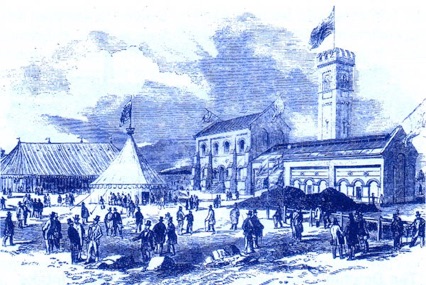Seething Wells

Seething Wells Water - Surbiton’s Hidden Heritage
About
Seething Wells
Seething Wells was a small area just outside Surbiton. There was not much there before 1848, except the main road from Kingston to Portsmouth, a few houses, pubs, a wharf and osier beds. This would be typical of what you would expect to see in a rural 19th century setting. Early maps call the area “Siden Wells” and show fields and farms.
There are some references to there being springs in the area. From at least the 18th century the spring had become “enclosed within a very old ivy covered well house containing a well and spring” (Ayliffe, 1914.36). The spring itself yielded “an abundant supply of water, whose hot waters were exploited medicinally, especially for opthalmia” (Biden, 1852. 34).
After lengthy negotiations, Lambeth Water Company bought land from the Earl of Lovelace at the end of 1849. Eviction notices were given to those living by the Thames at Long Ditton. The fate of the tenants is unknown. In all, as many as 200 people may have been cleared to make way for the works.
Impact on the local area
Construction Impact
The construction impact on the local area
The Construction of the Lambeth filter beds ran from 1850 to 1852 when the site opened. This was closely followed by the Chelsea Water Company which started construction in 1854 and opened in 1856. The change in the area must have been momentous, from a quiet, rural environment to a major construction site. A description of it in the Surrey Comet describes the scene as confusing and chaotic, with up to 800 men working there.
There were no machines to do the excavation, it was by manual labour. The people that carried this out were migrant labourers, who worked in gangs on projects such as building canals and railways. Looking in the 1851 census for Kingston we find 61 locals who were classed as “Excavator at Water Works.”
They lived close to the water works in groups, such as in Thomas Barrows’ household. He lived in Brighton Terrace with his wife Sarah and two daughters, Sarah Ann (age 5) and Phoebe (age 3). Along with them were 10 lodgers all of whom were excavators at the waterworks.
How the waterworks worked
How it worked
How the waterworks process worked?
The process was fairly straightforward. Water was pumped into the filter beds from the River Thames. It took 6 hours to slowly sink through layers of fine sand, followed by course sand, shells (from Harwich), fine gravel and finally course gravel. The shells overlapped and prevented sand sinking into the porous earthenware pipes below. This filtered any particles of dirt. Beneath all this were large ceramic pipes which drained the water to the pumping reservoirs.
Algae in the water and a layer of slime over the top consumed any living bacteria. In fact tests on working filters show bacteria can be reduced by up to factor of 10,000. The main reason for filtering was to get rid of any visible dirt. The effect of killing bacteria was unknown to Simpson and purely coincidental when Dr. John Snow used the water of Seething Wells to prove his theories in the spread of cholera.
The filter beds are still present. You can see them from Portsmouth Road. Some of them have been drained and the top level of slime is very clear and the undulating surface where the pipes lie beneath. The drains that conducted the water under the Portsmouth Road are still there and some still full of water. On the other side of the road, you can still see the Chelsea Coal Store with castle like tower, which is a lift shaft going underground.
The Nuffield health centre is within the Lambeth engine pump house, and is one of the oldest buildings on site. The original engines are still exist, but are found at Loughborough University.
© 2022 Proof from Seething Wells